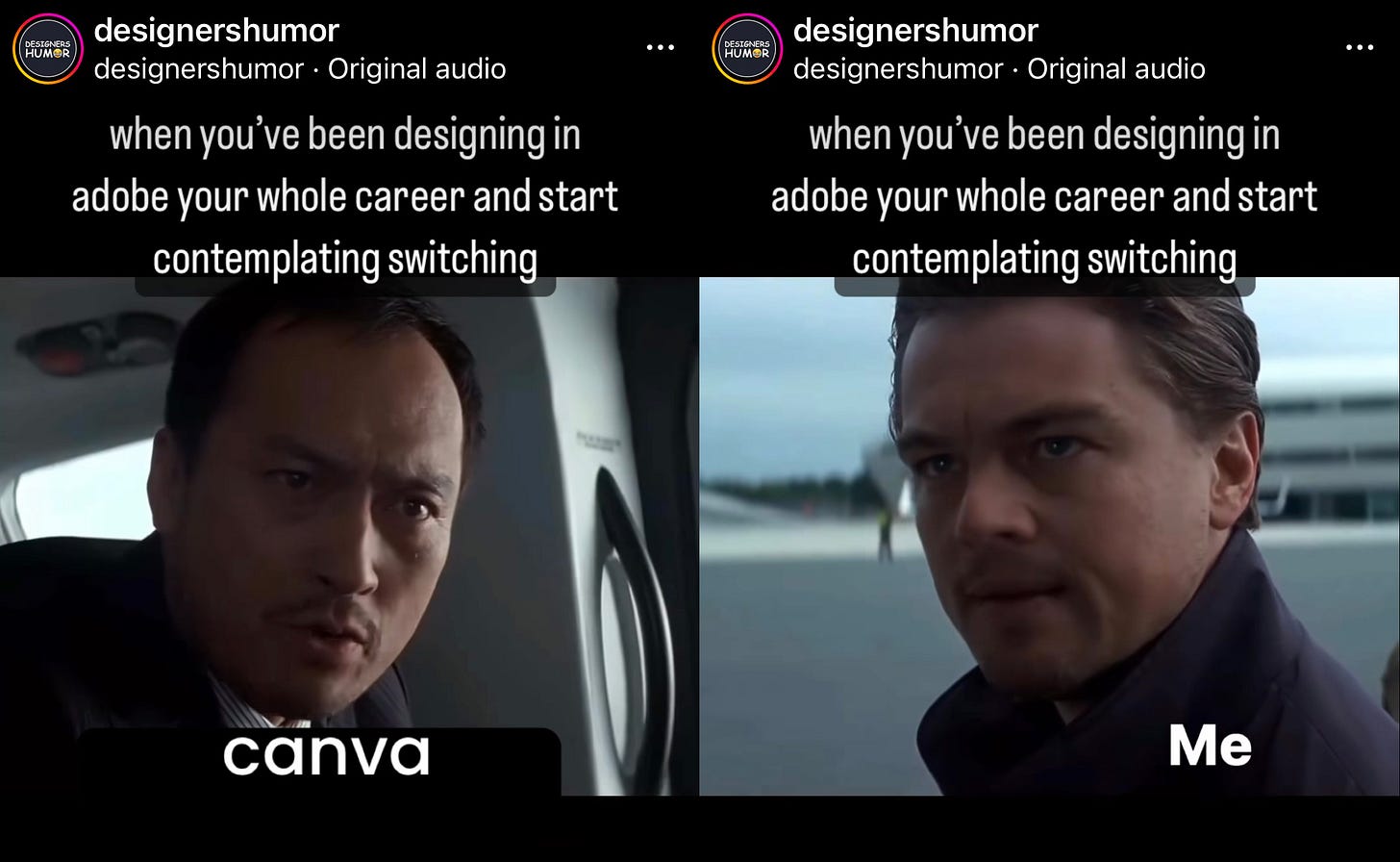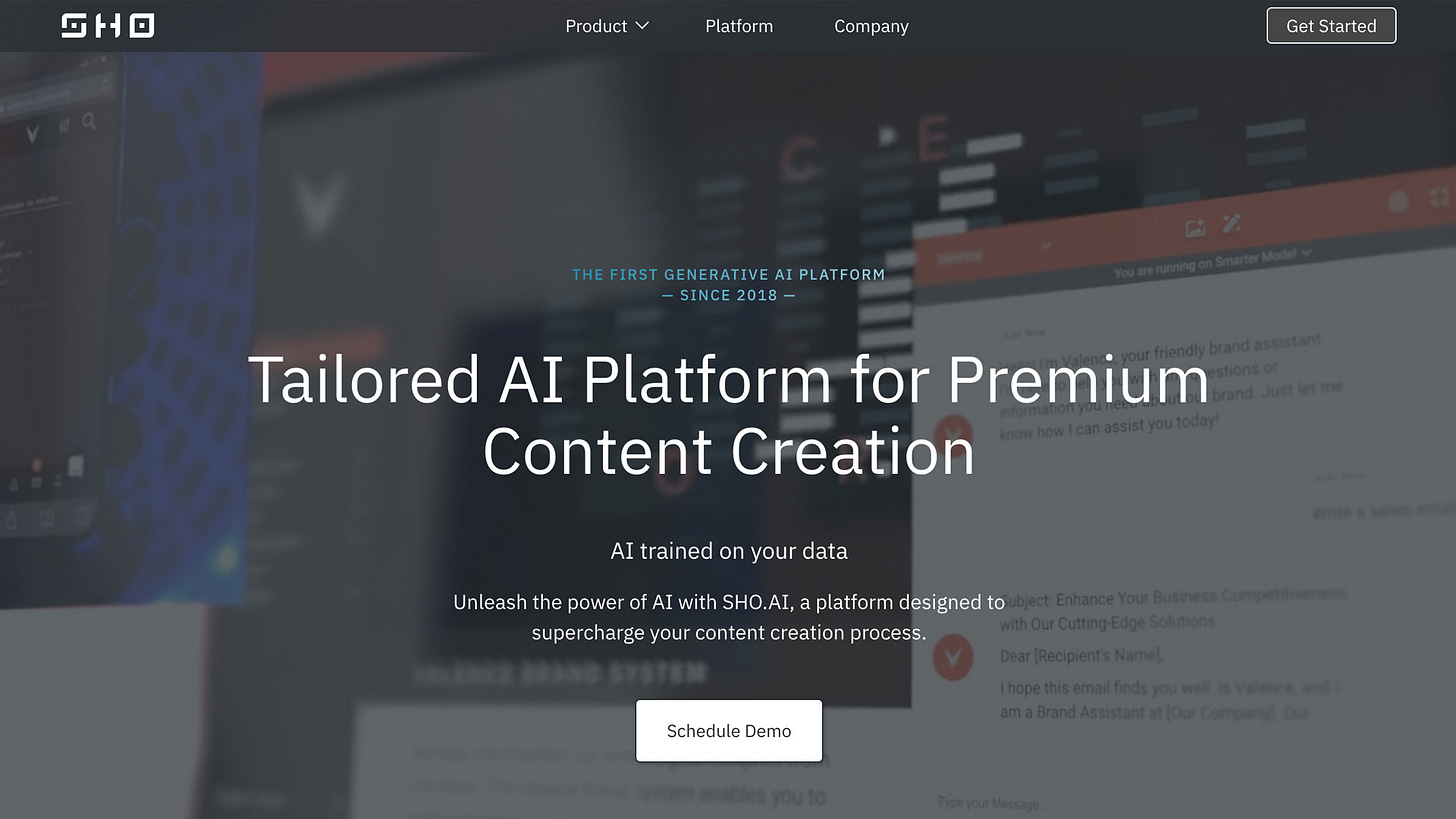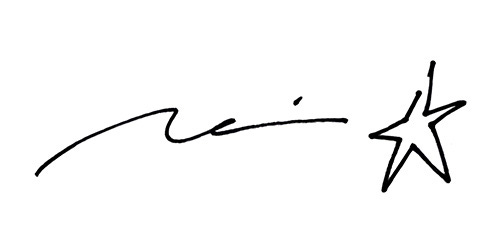
Designers vs. Canva
Designer: “I need a guarantee. How do I know you can deliver?”
Canva: “You don’t.”
Taking a scene from Christopher Nolan’s Inception, this exchange between characters played by Leonardo DiCaprio and Ken Watanabe exemplifies the tension between the old guard and the new guard of design, the trained and the DIYers, and dare I say, the professionals and the amateurs.
I spotted this clip on Designers Humor, a parody account with close to a million followers on Instagram alone. It is a collection of clever inside baseball memes for designers by a designer.

For those of us over 40, we grew up on Adobe. I milked my student copy of Adobe software as long as I could after I graduated from college. Adobe’s products first dominated the print graphic design industry in the 1990s and that continued into the 2000s when there was an increasing need for web design. Neither Photoshop nor Illustrator were meant for web or interface design but we made it work with them. For more than a decade, until the arrival (and short lives) of Sketch and InVision in the early 2010s, we endured the pain of designing web and app screens as PSDs—IYKYK—and handed them off as cut graphical assets and provided JPGs and PDFs as guides to developers for how the design should look when built.
When Figma launched in 2016, it didn’t take long for it to steal the thunder from Sketch and InVision for its collaboration features. Fast forward eight years, while Figma is valued at $20 billion and was almost bought by Adobe (but antitrust regulators stopped the deal in 2023), Sketch is alive but limited to Mac users only, and InVision announced it’s shutting down the service in 2024.
In the background, there was another tool that was brewing and growing: Canva. It was design software for the rest of them.
For us designers, Canva wasn’t a serious design tool. We still don’t want to admit that it is.
Democratization of design
“Do you think $500 is reasonable for someone to design a landing page?” asked a friend of mine just a few weeks ago.
This friend is an independent consultant who wanted to get a landing page designed for her business. She was referred to this designer, through her acquaintance, who quoted this price. She wanted my opinion, as a design professional, on whether this was a good market price.
“I ask because it sounds too cheap,” said my friend before I said anything.
Right after college, I moved to New York City with my twin brother to look for my first job. It was around the year 2000 right before the dotcom bubble and the market was still riding high. New York City at the time had a vibrant online scene, and web properties and companies were emerging and growing quickly. However, as a foreign student who just graduated with no work visa, the job market wasn’t easy. I had trouble landing a full-time gig.
One of the jobs I used to hustle for and take on was designing and coding web pages for articles for online publications. There were no sophisticated CMS systems or off-the-shelf web-design tools like Squarespace, Wix, or Canva that non-designers and non-coders could use to do such tasks.
Per one article, I would get paid a few hundred bucks. I would be given a written article in Microsoft Word, spend a few days doing a layout in Photoshop, and show it to the art director at the publisher. Based on feedback, I would address the design and turn that into a coded page for another round or two. This took about five to seven days.
I was single and living with my brother so we could keep our living expenses low. Also, New York City was much more affordable for young people then than it is now. Even if I could get a handful of these jobs that paid a few hundred dollars each, it was a struggle to make ends meet.
But that was more than 20 years ago. I’m not sure how far $500, before taxes, would go in 2024.
The work my friend wanted to get done was much trickier than designing and coding an article. It required the designer to interpret her business, distilling her selling point into a visual and textural narrative on a single page. My friend would be going back and forth with the designer for multiple weeks. $500 sounded like a bargain. That’s not even enough to be a day rate for many designers today.
Before passing judgment on the designer’s rate or their work, I asked “Do you know what kind of work this designer has done before?”
My friend showed me the designer’s landing page detailing their service. It didn’t include any previous work the designer had done. A warning sign? Perhaps. It did show, however, the detailed flow of their design service and I have to say, it looked professional and convincing enough. It looked like they were used to providing the design service for what my friend needed.
Upon further exploring this designer’s profile, it also became clear that they weren’t a practicing designer. Their Instagram account revealed that their main line of business was an organization consultant (not to be mixed with ‘organizational consultant’) with more than 50,000 followers. Each of their posts was well-designed and well-crafted.
It also said that the design would be delivered in Canva.
At this point, I had a mix of skepticism and curiosity. My friend regularly uses Canva for her business so this wasn’t necessarily bad news for her. Once the work is delivered in Canva, she won’t have to reengage the designer if she needs to make changes.
At the risk of sounding like an elite (and a douche), I told my friend I wouldn’t hire this designer for my needs, but also said that maybe it is good enough for what she needed, no offense.
To be honest, I was also curious what a non-designer designer could deliver for $500 using a free software tool.
AI for designers = Q for James Bond
“We saw quite a few design agencies go out of business in 2023,” said Sho Rust, the CEO/founder of Sho.AI, a design AI startup based in St. Louis.
This observation came up in my conversation with him a few weeks ago as we were discussing the future of design agencies and AI.
Sho.AI makes AI-powered design tools that streamline the management of brand design guidelines and the creation of branded content such as social media assets. Brands, particularly big ones, can use his startup’s tools to do those tasks much more efficiently and take redundancies out of tedious tasks such as producing or updating assets across multiple channels. Design agencies can use Sho.AI’s tools to sell their services at a lower rate to their clients so they can stay competitive in a market with heightened pressure to squeeze more with less.
However, Sho.AI’s tools aren’t for non-designers. One needs to have a solid understanding of design in order to be able to use Sho.AI well.
Sho himself describes the company’s AI tools like Q in James Bond. Bond already possesses impressive skills, but the tools Q invents for and provides to Bond make Bond exceptional and aid him in performing his impossible Secret Service duties. Sho.AI for designers is like Q for James Bond.
Just as Q’s tools can’t turn me into a James Bond, Sho.AI doesn’t turn a non-designer into a designer.
Do tools matter?
Digital takes what is for the elite and makes it accessible to everyone.
This was a phrase that we used to use at my previous agency.
Before personal computers, we needed to have access to not only a printing studio, a printing press, and a whole suite of heavy equipment, a variety of paper and inks, we needed experienced craftsmen and trained operators to turn written words into layouts and tangible visual information. Personal computers, specifically Macs, made that craft accessible to millions of people.
While software tools like QuarkXpress lowered the hurdle for design, they still required a level of training, knowledge, and experience. Design used to have a high bar. With the introduction of every successful design software tool over the past two decades, the bar kept getting lower and lower.
Tools like Canva eliminated that bar completely.
They took what used to be reserved for trained and skilled professional designers and made it accessible to anyone.
These tools may not turn non-designers into designers. But that is in a traditional sense. No one is stopping them from providing design services to anyone willing to buy it at a fraction of the cost of what a trained professional might charge.
Canva gives most people something that is good enough.
Good enough isn’t good enough
For $500, my friend decided to give it a go and have the landing page designed by the said designer using Canva. A week or so later, she received the first round of design and asked me how she should respond to the designer.
“What do you think?” Before I gave my thoughts, I asked her.
“Well, I’m not a designer and I don’t know how to articulate but…” searching for words, she replied. “It’s kind of simple. I don’t think it’s good. I don’t even think it’s good enough.”
When it comes to design, the difference between simple and simplistic is huge. The design provided to my friend was simplistic and lacked elegance. It had no sense of hierarchy or narrative. It was as if the designer took the first template they could find, and copied and pasted the text they were given. Photos seemed so generic that they may have been leftovers from the template.
There were plenty of warning signs but my friend wanted to give the benefit of the doubt. So did I.
Design apps like Canva can make design accessible to everyone. But how do you know that they can deliver?
You don’t.
It’s not the apps and tools that deliver. It’s the people.
Thanks for reading. Please hit reply if you have comments, questions, and feedback. I’d love to hear from you.






I did have to laugh in the end. Your tools v people is brilliant.
Great article and brain teaser, as always!
Perhaps the trick is understanding when to use which resource. I wouldn't want a non-designer designing my company's public face in the world. But I wouldn't pay a designer to create a flyer for my band's next gig. There's clearly demand for a design tool for non-designers, and I applaud the recognition of the power and importance of being able to communicate visually. Not everyone with Microsoft Word (or Google Docs) is a writer, and we don't argue about who should be using it. I believe the importance of visual communication is trickling down, and the tools are reflecting the moment we're in societally.
As to whether a tool can make people better designers, I think anyone who wants to be a better designer can learn it. And anyone who doesn't care, won't. But don't forget that our tools are opinionated, and they nudge our behaviors and decisions. Keynote makes much better looking slide decks than PowerPoint by default. Users don't have to work as hard to make things look good. And the evidence so far suggests that Canva is similar, that it has some design decisions baked in, or at least some shortcuts and defaults that consider design best practices.